
Chill Out! Your Guide to Aqua Cremation Coolers
The Future of Green Disposition: Aqua Cremation Technology
The funeral industry is evolving, and families are increasingly looking for gentle, eco-friendly options to honor their loved ones. As a funeral director, you've probably heard about aqua cremation coolers – specialized equipment that's changing how we think about final disposition.
These innovative systems use alkaline hydrolysis (also called aquamation or water cremation) instead of flames to accelerate the body's natural decomposition process. Using a combination of water, alkali, gentle heat, and sometimes pressure, these systems offer a peaceful alternative that many families find comforting.
| Aqua Cremation Cooler Essentials | Details |
|---|---|
| Process Name | Alkaline hydrolysis, aquamation, water cremation |
| Equipment Type | Stainless steel chamber with water circulation system |
| Operating Temperature | 199°F to 302°F (93°C to 150°C) |
| Energy Usage | Uses 90% less energy than flame cremation |
| Water Usage | Equivalent to a 4-person household's daily use |
| Process Duration | 3-16 hours depending on equipment model |
| Legal Status | Available in 28+ U.S. states (check local regulations) |
We're witnessing a meaningful shift in the mortuary world – a balancing act between honoring traditional practices while embracing innovations that reflect changing values. Aqua cremation coolers represent this evolution perfectly, offering a gentler approach that's been quietly changing funeral services for over a decade.
What makes this technology special? Unlike traditional flame cremation that releases carbon dioxide and other emissions, aqua cremation leaves virtually no environmental footprint. The process uses significantly less energy, produces no direct emissions, and actually returns about 20-32% more remains to the family compared to flame cremation – a meaningful difference for many.
For funeral homes considering this technology, understanding these specialized coolers is essential to making smart decisions about implementation, costs, and how to present this option to families who may be interested.
Here at American Mortuary Coolers, we've helped funeral homes nationwide integrate this innovative technology while maintaining their commitment to dignity and respect. As a national supplier with experience in both aqua cremation coolers and traditional mortuary refrigeration, we understand the unique challenges and opportunities this technology presents.
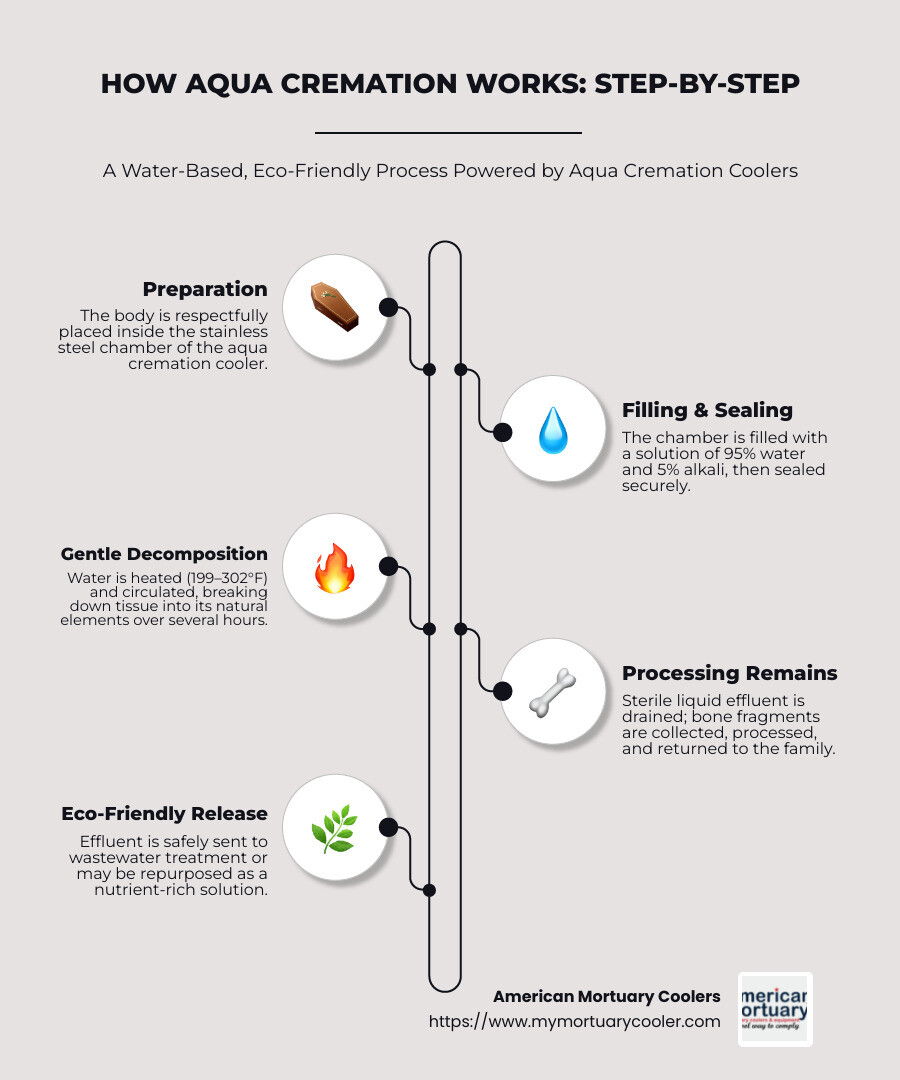
Understanding Aqua Cremation: Science & Process
When families ask about aqua cremation, they're often surprised to learn it's not a new technology, but rather a gentle process that works with nature instead of against it. As someone who's helped many funeral homes transition to this option, I've seen how understanding the science helps both professionals and families accept this alternative.
The Chemistry Behind the Process
Aqua cremation mimics what naturally happens when we're laid to rest in the earth—just in a more controlled, dignified way and on a much faster timeline. The process is beautifully simple:
The deceased is respectfully placed in a stainless steel vessel within the aqua cremation cooler. A solution of 95% water and 5% alkali (usually potassium hydroxide) fills the chamber. Then, the solution warms to between 199°F and 302°F—warm enough to accelerate natural processes but far cooler than flame cremation's 1,600°F temperatures.
I've always found Eric Bester's perspective quite moving: "Whether we realize it or not, water has a special meaning as who we are as individuals. We are water –– 65%. Born through water. Made of water. Often baptized through water. So it's kind of like a full circle. Go out through water."
During the 3-16 hour cycle (depending on your equipment model), this gentle bath transforms the body's complex molecules back to their basic building blocks—proteins become amino acids, fats convert to salts, and carbohydrates break down into simple sugars. There's something profoundly natural about this return to our elemental components.
What Remains After the Process
Once the cycle completes, two things remain:
First, pure white bone fragments that are typically 20-32% more abundant than with flame cremation, which can lose some bone material to the atmosphere. These calcium phosphate remains are dried, cooled, and processed into the fine powder that families receive—just as with traditional cremation, but often in greater quantity.
Second, a sterile liquid that Kelly Howard beautifully describes: "The process breaks down all organic materials into their most basic building blocks, so small that no trace of DNA remain. The organics are dissolved into the water, which consist of 96% water and 4% amino acids, salts and sugars by weight."
Historical Context
While it might seem cutting-edge, alkaline hydrolysis was actually patented back in 1888 for processing animal remains. Human applications began in the 1990s, with the Mayo Clinic adopting it in 2006 for bodies donated to science. Commercial funeral services first offered it in 2011 in Ohio and Florida.
Today, the numbers speak volumes—about 85% of families choose aqua cremation over flame cremation when given the option. Many are drawn to its gentler approach, absence of flame, and significant environmental benefits.
Aqua cremation coolers have evolved considerably since those early days, with modern systems featuring advanced temperature control, efficient water circulation, and comprehensive safety features that make the process both dignified and practical for funeral homes of all sizes.
For a deeper dive into how this process works step-by-step, visit our comprehensive guide to the water-based cremation process. For industry standards and practices, the Cremation Association overview offers excellent resources for both professionals and families.
Aqua Cremation Coolers: Design, Installation & Maintenance
The heart of the aqua cremation process is the equipment itself—the aqua cremation cooler. These sophisticated systems are engineered specifically to provide a dignified, efficient, and environmentally friendly alternative to flame-based cremation. At American Mortuary Coolers, we've watched these systems evolve to meet the growing demand for green disposition options, and we're proud to be part of this positive change in the funeral industry.
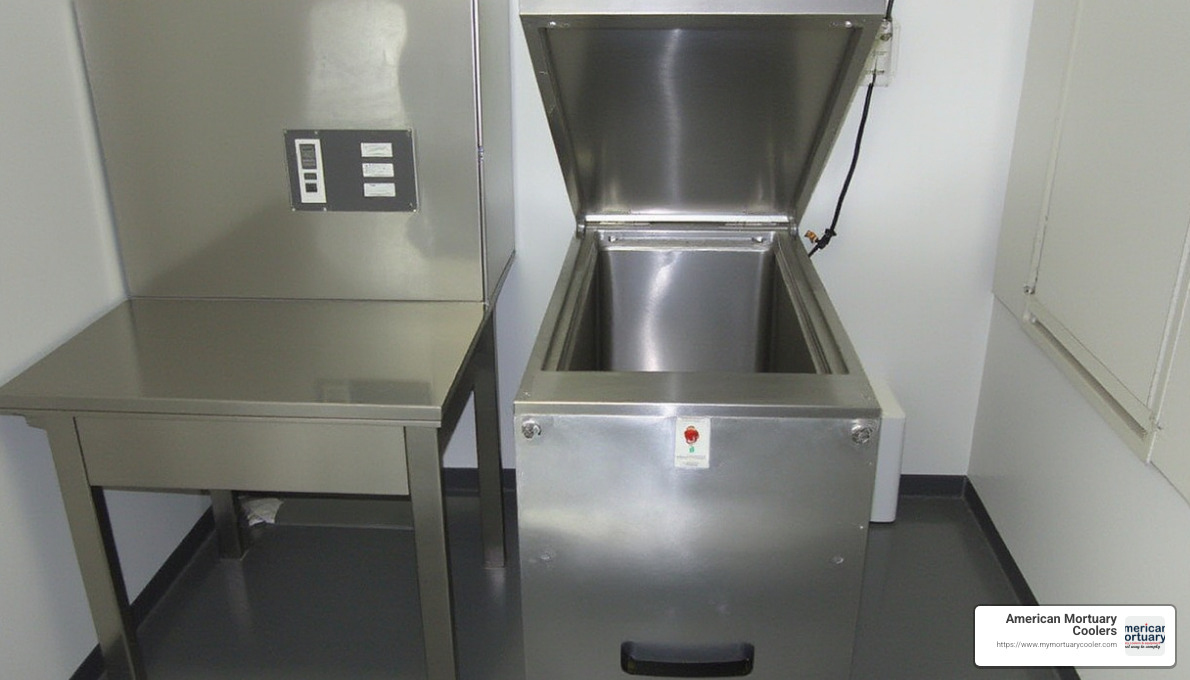
The Anatomy of an Aqua Cremation System
An aqua cremation cooler isn't just a fancy container—it's a thoughtfully engineered system that handles a delicate process with dignity and precision. When you peek inside one of our systems, you'll find a stainless steel chamber that's built to withstand the alkaline solution while maintaining precise temperature control. This chamber works alongside a water circulation system that keeps everything moving smoothly, ensuring even and efficient processing.
The magic happens with heating elements that maintain temperatures between 199-302°F, depending on which model you choose. Modern units come with smart control systems that monitor everything from temperature to pressure, making adjustments automatically so you don't have to.
"I was surprised by how compact the equipment is," shared one funeral director who recently installed our system. "We didn't need to build a separate structure or fancy ventilation systems like with traditional cremation. The savings on setup costs alone were significant."
After the process completes, the effluent handling system takes care of the sterile liquid that remains, containing and neutralizing it as needed before proper discharge. It's all designed with both efficiency and respect in mind.
Installation Considerations
Setting up an aqua cremation cooler is typically more straightforward than you might expect. Most funeral homes find they need about 150-200 square feet of floor space—less than you'd need for a traditional crematory. You'll need access to water, drainage, and appropriate electrical service (usually 220V), along with water-resistant flooring that can handle occasional moisture.
One of our clients in Colorado told us, "The installation took about three days, which was a pleasant surprise compared to the weeks of construction and permitting headaches we faced with our traditional crematory. And it's so quiet! There's no roaring flame or industrial noise—just a gentle hum."
The regulatory process tends to be less complex than with flame cremation too, though requirements vary by location. We're always happy to help steer those waters with you—just part of the service we provide at American Mortuary Coolers.
For more insights about these systems, check out our Aqua Cremation Explained resource page.
Technical Features of Aqua Cremation Coolers
The technical side of aqua cremation coolers is where things get interesting (at least for equipment nerds like us). The primary circulation system is the heart of the operation, with high-efficiency pumps keeping everything flowing smoothly, heat exchangers transferring thermal energy efficiently, and filtration systems preventing clogs.
Modern units are smarter than you might think. They include pH sensors that continuously monitor the solution's alkalinity, temperature probes placed strategically to ensure even heating, and pressure transducers in pressurized systems to keep everything safe. All of this is managed by automated PLC systems that make real-time adjustments for optimal efficiency.
Safety features are built into every aspect of our designs. Emergency shut-offs can halt the process immediately if something looks off, pressure relief valves prevent over-pressurization, and leak detection systems alert operators to potential issues. We also include lockout mechanisms to prevent unauthorized access during operation—because safety isn't just a feature, it's a promise.
For those who enjoy diving into the science behind these systems, the Cremation Association's research on water-based dissolution offers excellent technical background.
Sizing & Custom Options for Aqua Cremation Coolers
At American Mortuary Coolers, we know that funeral homes come in all shapes and sizes, serving communities with diverse needs. That's why our aqua cremation coolers aren't one-size-fits-all. We offer single-capacity systems for smaller funeral homes just dipping their toes into aqua cremation, multi-capacity systems for busier operations, and even pet-specific units scaled appropriately for our four-legged family members.
Where we really shine is customization. Need a system to fit an unusually shaped space? No problem. Want modular rack systems for more efficient processing? We've got you covered. Looking for specific door configurations that make your workflow smoother? Consider it done.
"Having the ability to specify exactly what we needed made all the difference," shared a funeral director in Tennessee who purchased one of our custom systems. "Our space had unusual dimensions, but American Mortuary Coolers designed a system that fit perfectly and matched our workflow requirements."
If you're curious about what might work best for your facility, we'd love to chat about it. You can Get a Quote for custom coolers custom to your specific needs.
Safety & Staff Training Essentials
Operating aqua cremation coolers safely isn't complicated, but it does require proper training and consistent protocols. Personal protective equipment is a must—chemical-resistant gloves when handling alkali solutions, face shields or safety glasses to protect against splashes, non-slip footwear, and protective clothing to prevent skin contact with chemicals.
We recommend implementing straightforward safety measures like lock-out/tag-out procedures during maintenance, proper chemical storage for alkali solutions (following OSHA guidelines), regular pH monitoring of effluent, and documented safety checks throughout the process.
Training is something we take seriously. All operators should receive initial certification and hands-on practice with experienced technicians. We cover emergency response procedures for potential chemical spills or equipment malfunctions, and we encourage regular refresher courses as equipment and protocols evolve.
"The training provided by American Mortuary Coolers was thorough and practical," noted one of our clients in Georgia. "Our staff felt confident operating the equipment from day one, and the ongoing support has been invaluable for our team."
We believe that when it comes to safety, there's no such thing as being too prepared. That's why we're committed to providing not just equipment, but the knowledge and support that helps you use it with confidence.
Environmental, Cost & Legal Landscape
The growing popularity of aqua cremation coolers isn't just about technological innovation—it's driven by compelling environmental benefits, evolving cost considerations, and an increasingly favorable legal landscape. Understanding these factors is crucial for funeral homes considering this technology.
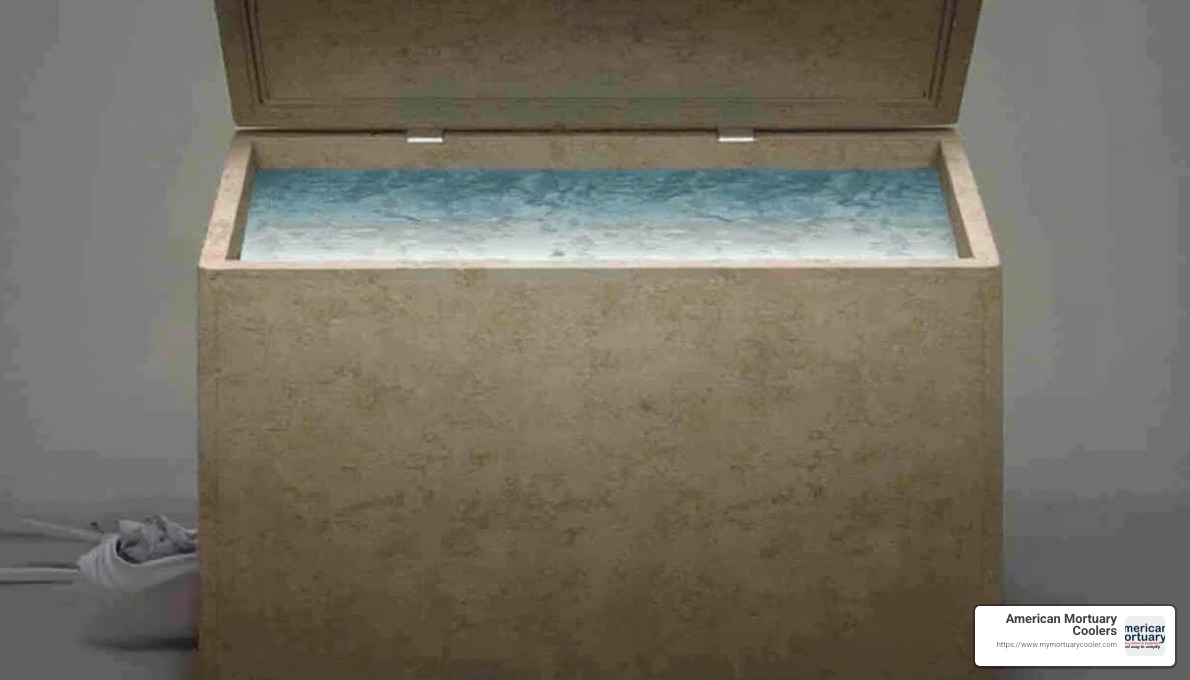
Environmental Benefits
When families learn about the environmental advantages of aqua cremation, many are genuinely surprised by how significant they are. The process is remarkably gentle on our planet in several important ways.
First, there's the energy savings. Aqua cremation coolers use over 90% less energy than traditional flame cremation. Think about it - flame cremation requires temperatures above 1500°F sustained for two hours, while aqua cremation operates at much lower temperatures between 199-302°F. That's a tremendous difference in energy consumption!
There's also the matter of emissions. Unlike flame cremation, which releases carbon dioxide and other pollutants directly into our atmosphere, aqua cremation produces no airborne emissions whatsoever. As John Humphries, founder of Aquamation®, beautifully puts it: "Water Cremation, by Aquamation® uses water instead of fire to return a loved one back to nature."
Another benefit that many don't consider is mercury elimination. Traditional cremation can release mercury from dental fillings into the air we breathe. With aqua cremation coolers, mercury and other metals are safely contained and can be properly recovered and handled.
And what about water usage? Yes, the process uses water, but the amount is equivalent to what a typical family of four uses in just one day. In many jurisdictions, the sterile effluent can even be recycled or used as fertilizer, making it a truly circular process.
Cost Considerations
Let's talk dollars and sense when it comes to aqua cremation coolers. The economics involve several factors that funeral directors should weigh carefully.
On the equipment side, a new aqua cremation unit typically costs around $165,000. While that might seem substantial, it's important to compare this to traditional crematory equipment, which often requires additional construction and ventilation systems that can drive up the total investment significantly.
Installation costs tend to be lower than flame crematories too. There's no need for specialized ventilation or emissions control equipment, which means less construction and lower setup costs. As one funeral director in Washington shared with us: "Our investment in aqua cremation paid for itself faster than expected. The lower operating costs combined with growing consumer demand meant we reached our break-even point within 18 months."
The day-to-day operational costs are where many funeral homes see compelling advantages. Those significant energy savings I mentioned earlier? They translate directly to lower utility bills month after month, year after year.
From the consumer perspective, aqua cremation services typically cost around $2,000, compared to approximately $3,000 for flame cremation. This price point makes it an attractive option for families who are both environmentally conscious and budget-aware. Many funeral homes report increased case volume after adding this service, as it appeals to a growing segment of consumers looking for greener alternatives.
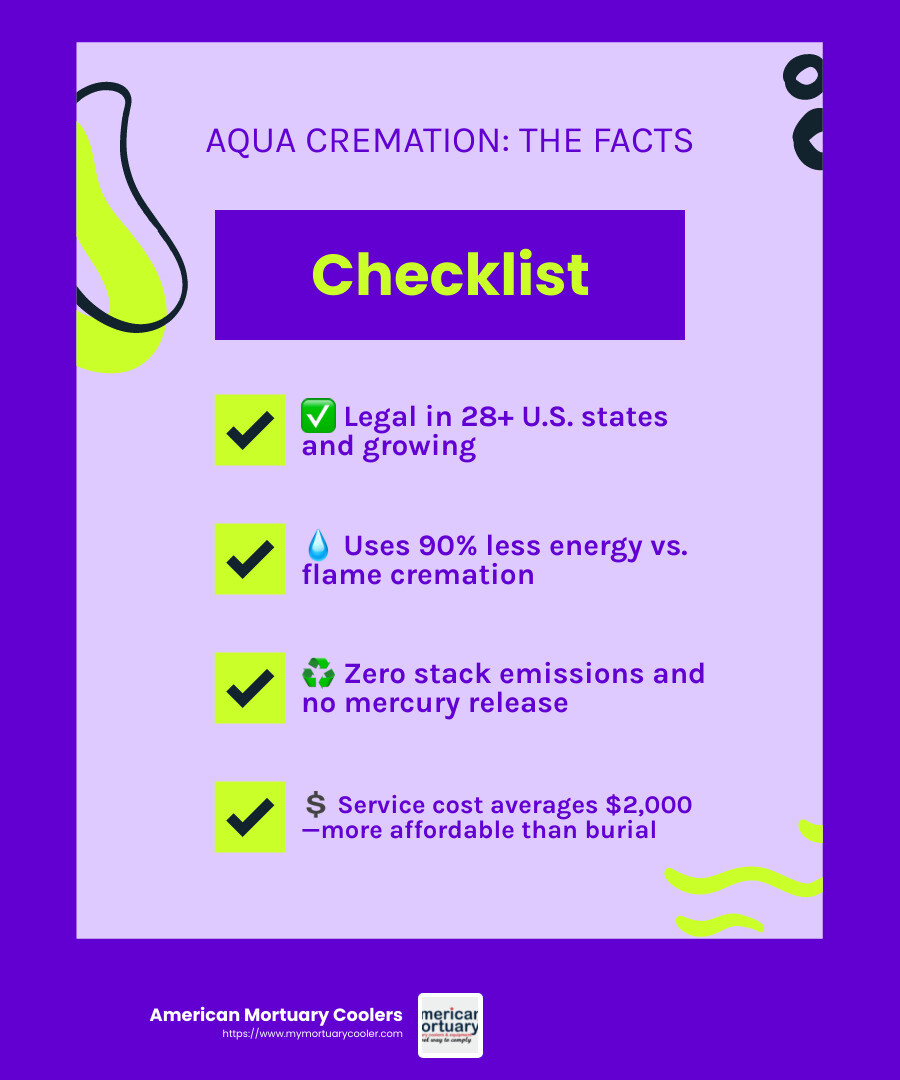
Legal Status and Regulatory Environment
The regulatory landscape for aqua cremation coolers continues to evolve in a positive direction. Currently, aqua cremation is legal in over 28 states, including major markets like California, Texas, and Georgia, with legislation pending in several others.
This growing acceptance makes sense when you consider the benefits. In states where it's approved, aqua cremation typically falls under existing cremation regulations, which simplifies the permitting process for funeral homes. This streamlined regulatory approach makes implementation much more straightforward than many funeral directors initially expect.
The trend extends beyond our borders too. Beyond the U.S., countries including Canada, Australia, and parts of Europe have approved and implemented aqua cremation, indicating a global movement toward acceptance of this gentle disposition method.
For funeral homes considering this technology, it's worth noting that consumer awareness and acceptance continue to grow steadily. According to industry surveys, when families are offered both options and properly educated about the differences, about 85% choose aqua cremation over flame cremation. That's a powerful indicator of where consumer preferences are heading.
The combination of environmental benefits, reasonable costs, and increasingly favorable regulations creates a compelling case for funeral homes to consider adding aqua cremation coolers to their service offerings. As more consumers seek greener end-of-life options, having this capability can become a significant competitive advantage.
For more information on the environmental aspects, visit our guide on Going Green with Water Cremation or read the Reuters report on no fossil fuels used in the process. You can also check our comprehensive guide on Water Cremation Laws by State to understand the legal status in your area.
Frequently Asked Questions about Aqua Cremation Coolers
When I talk with funeral directors considering aqua cremation coolers for their facilities, certain questions come up time and again. Let's walk through the most common ones together—the same questions families often ask when exploring this gentle alternative.
What happens to the water and effluent after the cycle?
This question tops the list for both professionals and families alike. After the aqua cremation process completes, what remains is a sterile liquid that's completely transformed from its original state.
The effluent is entirely pathogen-free—the combination of high alkalinity and heat destroys all viruses, bacteria, and even prions (which are notoriously difficult to eliminate). There's no trace of DNA left either, as the process breaks down all genetic material completely.
What's fascinating is what this liquid actually contains: amino acids, peptides, sugars, and salts—all natural organic compounds that plants love. After neutralizing the pH, the solution meets all wastewater requirements for safe discharge.
I remember speaking with a funeral director in Oregon who found a beautiful way to complete the circle of life: "We partnered with a local tree farm that uses the neutralized effluent as fertilizer. Families find profound comfort knowing their loved ones are literally nurturing new growth."
Some of our partners work directly with municipal treatment plants, where operators actually appreciate the nutrient content that can improve their biological treatment processes. Nature wastes nothing, and neither does this process.
How much energy and water does an aqua cremation cooler consume?
When weighing the practical aspects of aqua cremation coolers, understanding resource usage helps paint the complete picture.
The energy savings are truly remarkable—about 90% less energy than traditional flame cremation. To put that in perspective, a single pet aquamation cycle saves enough energy to drive from Nashville to Chicago. That translates directly to your utility bills, as one director in Illinois shared with me: "Our monthly energy costs dropped by over 60% after switching from flame to water cremation."
As for water usage, the process typically needs about 100-300 gallons per cycle—roughly what a family of four uses in a day of normal activities. The important part is that 99% of this water returns to the ecosystem through proper treatment, making the actual consumption quite minimal.
These efficiency gains aren't just good for the planet—they're good for your bottom line too.
Is aqua cremation legal in my state?
The legal landscape for aqua cremation coolers continues to evolve in a positive direction. Currently, more than 28 states have approved this technology, including major states like California, Texas, Florida, and New York.
Several additional states have legislation under consideration, reflecting growing public interest in greener disposition options. Even in states where it's legal, availability depends on local funeral homes having invested in the equipment.
I've worked with families who traveled across state lines to access this option—that's how strongly some people feel about choosing this gentler approach.
For the most up-to-date information specific to your location, I recommend checking our Water Cremation Laws by State guide, which we keep current as regulations change.
What makes aqua cremation remains different from flame cremation remains?
Families notice several meaningful differences in the remains they receive after aqua cremation compared to flame cremation.
First, the appearance is distinctly lighter—white to tan rather than gray—because the remains haven't been exposed to carbon and smoke. This purer appearance resonates with many families seeking a "cleaner" process.
You'll also return approximately 20-32% more remains to families with aqua cremation. This happens because flame cremation inevitably destroys and expels some bone material into the atmosphere. The greater volume often allows families to create multiple keepsakes or memorial items.
The texture differs too—aqua cremation remains tend to be more brittle and powdery, making them particularly suitable for scattering ceremonies or incorporating into memorial plantings and living tributes.
As one industry professional, Eric Bester, put it: "If you could put the two side-by-side and see how they operate, open the door of both of them, no family would choose to go in that fire brick oven over the aquamation process." It's a perspective I've heard echoed by many families who appreciate what they see as a gentler approach.
Can pacemakers and other implants remain in place?
Here's a practical advantage that simplifies preparation: unlike flame cremation, where pacemakers must be removed to prevent explosion, most medical implants can safely remain in place during aqua cremation.
This includes pacemakers, joint replacements, and other prosthetics, which are typically recovered intact after the process. Even dental work like gold fillings and other materials are preserved and can be returned to the family if desired.
For many families, the recovery of precious metals from dental work or jewelry holds significant sentimental or practical value—another small but meaningful benefit of choosing aqua cremation coolers for your facility.
Conclusion
As we've explored throughout this guide, aqua cremation coolers represent more than just technological innovation—they embody a fundamental shift in how we approach end-of-life care with environmental consciousness and dignity. At American Mortuary Coolers, we're proud to be at the forefront of this evolution, providing funeral homes across the nation with durable, tailor-made solutions that meet the growing demand for sustainable disposition options.
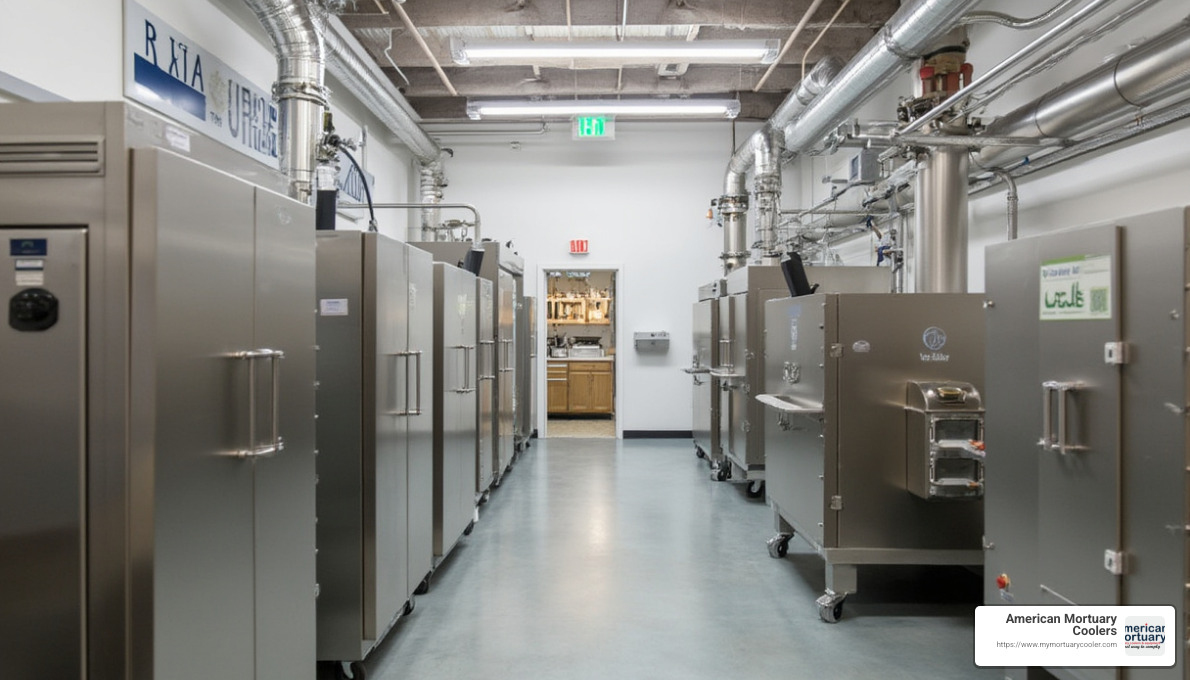
The Path Forward
For funeral homes considering adding aqua cremation to their services, the benefits speak for themselves. You'll position your business as an environmental leader in your community, something more and more families are actively seeking. The significant energy savings translate directly into reduced operating costs - a welcome change in today's economic climate.
Beyond the practical benefits, you'll be able to expand your service offerings to meet the evolving preferences of today's families. This natural differentiation helps you stand out in an increasingly competitive market.
I recently spoke with a funeral director in Atlanta who shared her experience after installing our system: "Adding aqua cremation has transformed our business. We're attracting families who might never have considered us otherwise, and our reputation as an environmentally conscious provider has spread throughout the community. Word-of-mouth has become our best marketing tool."
Our Commitment to You
At American Mortuary Coolers, we understand that bringing new technology into your funeral home isn't just about equipment delivery. It's about partnership. That's why when you work with us, you're getting so much more.
We provide comprehensive training for your entire staff, ensuring everyone feels confident with the new technology. Our experienced team offers ongoing technical support - we're just a phone call away whenever questions arise. We even provide marketing assistance to help you effectively communicate these benefits to the families you serve.
Many funeral directors tell us the regulatory landscape seemed daunting at first, which is why our regulatory guidance has proven so valuable in steering them through the permitting process with minimal headaches.
With locations across the United States—including Johnson City TN, Atlanta GA, Chicago IL, Columbia SC, Dallas TX, Los Angeles, New York NY, and Pittsburgh PA—we're proud to provide direct service to funeral homes in all regions of the contiguous 48 states.
Taking the Next Step
Whether you're ready to implement aqua cremation immediately or simply exploring options for the future, we're here to help you make the best decision for your business and the families you serve.
We invite you to explore our full Aquamation Equipment line to see our complete range of aqua cremation coolers and related equipment. Our specialists are available for personalized consultations to answer your specific questions about implementation in your facility. Many funeral directors find it helpful to request a demonstration of our equipment in action - seeing is believing when it comes to this gentle technology.
As the funeral industry continues to evolve, providing families with dignified, meaningful ways to honor their loved ones remains at the heart of what we do. Aqua cremation offers exactly that—a gentle, environmentally conscious alternative that resonates with today's families while preparing your business for tomorrow's expectations.
We at American Mortuary Coolers are ready to walk this journey with you, bringing our decades of experience to ensure your success with this innovative technology. Together, we can offer families the gentle farewell they deserve while protecting the planet for generations to come.



